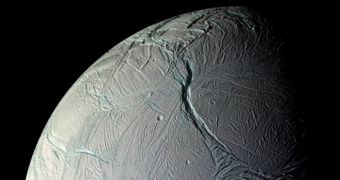The South Pole of Saturn's moon Enceladus is one of the most peculiar regions in the solar system. For quite some time, astronomers have known that weird heat-related phenomena take place there, and also that the crust appears to be churned from the inside. Numerous theories aimed at explaining why this is the case have been proposed, but none of them has managed to accurately explain the occurrences. Now, after analyzing new data obtained by the NASA/ESA Cassini spacecraft, experts have been able to gain more knowledge on the moon, PhysOrg reports.
“This episodic model helps to solve one of the most perplexing mysteries of Enceladus. Why is the south polar surface so young? How could this amount of heat be pumped out at the moon's south pole? This idea assembles the pieces of the puzzle,” Cassini project scientist Bob Pappalardo says. He holds an appointment at the NASA Jet Propulsion Laboratory (JPL) in Pasadena, California.
The newly collected sets of pieces of information hint at the fact that the explanation for these peculiar occurrences lies with blobs of warmer ice, which rise from within Enceladus. There is a great deal of ongoing speculation as to whether an ocean of liquid water exists deep beneath the outer ice crusts, or whether the core is as solid as the surface. The new Cassini data show that the blobs lift from under the ices at regular intervals, and also that they tend to churn the surface as they do. This also explains why the surface of the South Pole looks the way it does.
“Cassini appears to have caught Enceladus in the middle of a burp. These tumultuous periods are rare and Cassini happens to have been watching the moon during one of these special epochs,” University of California in Santa Cruz (UCSC) planetary scientist Francis Nimmo says. He is the coauthor of a new paper detailing the findings, which appears in the latest issue of the renowned scientific journal Nature Geoscience. The researcher is also keen on pointing out that this research does not link the formation of jets and fissures on Enceladus to the churning and resurfacing processes.
According to the new model, the insides of Enceladus are periodically heated up, causing blobs of ice to rise to the surface. The process is similar to the one encountered in lava lamps, where the heat applied at the bottom forces the wax blobs to go up. As this happens on the Saturnine moon, other blobs of cooler ice are sent to the interior of the natural satellite. This causes the temperature variations that Cassini previously recorded. The rising, warm ice has a temperature of about 273 degrees Kelvin or 32 degrees Fahrenheit, or just below the freezing point. The ice going down reaches a chilly 80 degrees Kelvin or -316 degrees Fahrenheit.

 14 DAY TRIAL //
14 DAY TRIAL //